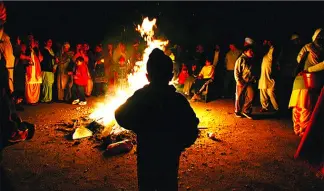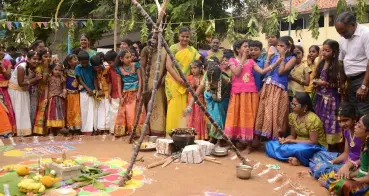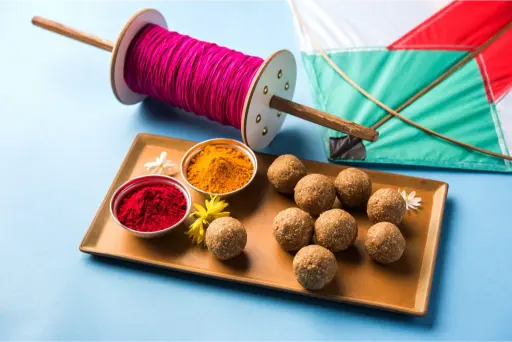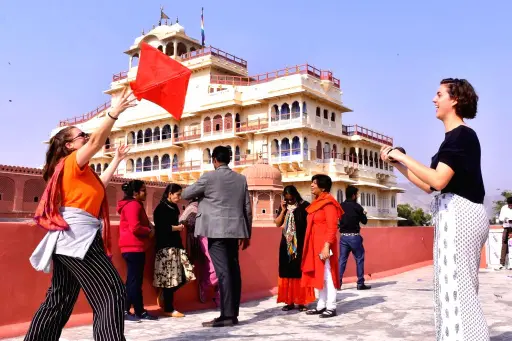As January dawns, India transforms into a vibrant tapestry of celebrations, ablaze with the spirit of harvest, gratitude, and the timeless dance of the seasons. Draped in its festive splendor, the nation rejoices with unparalleled fervor, honoring the cyclical rhythm of nature’s bounty. This period marks the arrival of Lohri, Pongal, and Makar Sankranti festivals that signify gratitude, joy, and the eternal bond between nature and humanity. Each of these festivals, celebrated under different names across India, reflects the diversity and unity of its cultural tapestry. Let’s embark on a journey to explore their unique flavors and the rich heritage they carry.
Lohri: A Fiery Celebration of Gratitude and Joy in Northern India

As the chilly winter nights give way to the promise of longer days, the northern regions of India, particularly Punjab and Haryana, come alive with the vibrant festival of Lohri. Celebrated on January 13, this joyous occasion heralds the end of winter and marks the Sun’s northward journey, known as Uttarayan.
At its core, Lohri is a harvest festival, deeply rooted in agrarian traditions. It is a time to express gratitude to nature for a bountiful yield, especially crops like sugarcane and wheat. The bonfire, which forms the centerpiece of the celebration, symbolizes warmth, abundance, and the triumph of light over darkness. Families and friends gather around the roaring flames, offering sesame seeds, jaggery, peanuts, and sugarcane to thank the gods for their blessings.
For newlyweds and families with newborns, Lohri holds special importance. These individuals receive blessings and partake in grand celebrations, symbolizing new beginnings and prosperity.
Related: The History Behind Holi and Why It is Celebrated?
How Lohri is Celebrated
- Bonfire Rituals: As dusk falls, a large bonfire is lit in open spaces or courtyards. People circumambulate the flames, throwing offerings of sesame seeds, puffed rice, and other items into the fire while praying for health, happiness, and abundance.
- Dance and Music: No Lohri celebration is complete without the electrifying beats of the dhol. Traditional dances like Bhangra and Gidda set the rhythm of the evening, with participants dressed in vibrant ethnic attire.
- Feasting: The festival’s culinary highlights include dishes made from jaggery, sesame, and mustard greens. Makki di roti (corn flatbread) and sarson da saag (mustard greens) are iconic staples of a Lohri feast, paired with desserts like gajak and til laddoo.
- Folk Songs: Traditional Punjabi folk songs narrating tales of folklore heroes, such as Dulla Bhatti, resonate around the bonfire, adding a touch of nostalgia and cultural pride to the festivities.
A Celebration of Agrarian Culture
Lohri’s connection to farming and harvest cannot be overstated. It marks the sowing of rabi crops, especially wheat, which are the backbone of Punjab’s agrarian economy. The festival is also intertwined with the Hindu festival of spring, bridging seasonal transitions and celebrating the cyclical nature of life.
Pongal: Tamil Nadu’s Tribute to Prosperity and Nature

In the culturally rich southern state of Tamil Nadu, Pongal stands as a resplendent celebration of the harvest season and the profound connection between humans and nature. This vibrant festival derives its name from the Tamil word “pongu”, meaning “to overflow,” a fitting metaphor for prosperity, abundance, and gratitude.Spanning four days, Pongal aligns seamlessly with the Sankranti festival meaning, offering thanks to the Sun God, nature, and cattle, whose contributions are vital to a successful harvest. This year, Pongal festivities will begin on January 14, 2025, and continue until January 17 (Friday), according to Drik Panchang. The auspicious time for performing puja is between 8:00 AM and 10:30 AM, adding a spiritual essence to the grand celebrations
The Four Days of Pongal: A Symphony of Tradition
- Bhogi Pongal: The festival begins with a ritual cleansing of both homes and minds. Families discard old belongings in a symbolic act of renewal, paving the way for positivity and new beginnings. This day is also marked by traditional dances and songs celebrating the agrarian lifestyle.
- Surya Pongal: The second day, dedicated to the Sun God (Surya), forms the heart of the celebration. A special dish called Pongal a sweet concoction of freshly harvested rice, jaggery, and milk is prepared in decorated earthen pots. As the dish overflows during cooking, it symbolizes abundance and blessings. Families gather to offer this dish to the Sun, thanking it for sustaining life.
- Mattu Pongal: This day is dedicated to cattle, revered as vital partners in agriculture. Cows and bulls are adorned with vibrant colors, garlands, and bells, and special prayers are offered. In some villages, traditional bull-taming contests, such as Jallikattu, are held, adding an exciting and historical dimension to the day.
- Kaanum Pongal: The final day is all about social bonding. Families and communities come together for picnics, feasts, and cultural events, fostering unity and goodwill. People also visit elders to seek blessings, strengthening familial ties.
Pongal’s Deep Connection to Nature
Pongal is more than just a festival; it is a way of life that celebrates sustainability and the harmonious relationship between humans and the environment. It underscores the importance of respecting nature and acknowledging its pivotal role in sustaining livelihoods.
The rituals of Pongal highlight the Hindu festival of spring, marking the Sun’s transition into the zodiac sign of Capricorn (Makara Sankranti) and symbolizing longer days and renewed energy.
The Culinary Delight of Pongal
At the heart of the festival is the traditional dish Pongal, a simple yet deeply symbolic preparation. Cooked in clay pots, the dish is flavored with jaggery, cardamom, and cashews, representing the sweetness of life. Savory versions, such as ven pongal, are also enjoyed, paired with coconut chutney and sambar.
Makar Sankranti: A Celebration of Light, Harvest, and the Sun’s Celestial Journey

As the Sun begins its northward journey, known as Uttarayana, India comes alive with the vibrant festivities of Makar Sankranti. This festival celebrated across the country with unique regional variations, marks the transition of the Sun into Makara Rashi (Capricorn) and signifies the end of winter and the beginning of longer, warmer days. In 2025, the festival of Makar Sankranti will fall on 14 January, which is on Tuesday.
A deeply spiritual and cultural event, Makar Sankranti is not just a festival but a celestial celebration that ties humanity to the rhythm of the cosmos.
The Regional Flavors of Makar Sankranti
Makar Sankranti is one of the few Indian festivals celebrated on a fixed date, January 14, and its traditions vary across states, reflecting the diversity of Indian culture.
1. Gujarat: A Sky Full of Kites
In Gujarat, Makar Sankranti transforms into a joyful spectacle with the International Kite Festival. The skies become a canvas of colors as people fly kites, symbolizing freedom, hope, and aspirations. Known as Uttarayan in this region, the festival is accompanied by feasting on special snacks like undhiyu (a mixed vegetable dish) and chikki (peanut and jaggery brittle).
2. Maharashtra: Sweetness in Relationships
In Maharashtra, the festival carries a social message of unity and harmony. Families exchange tilgul (sweets made of sesame seeds and jaggery) with the words “Tilgul ghya, ani goad goad bola” (Take these sweets and speak sweetly), symbolizing sweetness in relationships. Married women are invited to gatherings called Haldi-Kumkum, fostering bonds of friendship and goodwill.
3. Karnataka and Andhra Pradesh: Patanjali Sankranti
Known as Patanjali Sankranti in parts of Karnataka and Andhra Pradesh, the festival is marked by cultural performances, decorating cattle, and preparing festive dishes like sakkare acchu (sugar figurines), and ellu-bella (a mix of sesame, jaggery, and coconut). Traditional rangoli designs adorn the courtyards, adding a splash of color to the festivities.
4. West Bengal: The Sacred Ganga Sagar Mela
In Bengal, Makar Sankranti takes on a deeply spiritual tone. Devotees gather at the Ganga Sagar Mela, held where the Ganges meets the Bay of Bengal, to take holy dips and offer prayers. This ritual is believed to cleanse sins and bring spiritual blessings. Special sweets made from date palm jaggery, like patishapta and pithe, are culinary highlights.
Related: Complete Guide to Celebrate Holi 2025 As a female traveler in India
Astronomical and Seasonal Significance
Makar Sankranti holds great astronomical importance as it marks the Sun’s shift into Capricorn and the start of Uttarayana, the six months considered auspicious in Hindu tradition. This transition also signifies the arrival of spring and the end of the Sawan month, an important period in the Hindu calendar.
The festival is not just a celebration of the harvest but also a harbinger of light, warmth, and new beginnings. It symbolizes the movement from darkness to light, both literally and metaphorically.
The Spiritual Connection to Sawan Month
Though Sawan month (Shravan) is not directly linked to the winter harvest festivals, its spiritual undertones deeply resonate with the themes celebrated during Lohri, Pongal, and Makar Sankranti. As one of the holiest months in the Hindu calendar, Sawan emphasizes gratitude towards nature, celestial alignments, and the cyclical rhythm of life all of which are echoed in these festivals.
The month of Sawan is dedicated to Lord Shiva, with devotees observing fasts and performing rituals to seek blessings for prosperity and harmony. Similarly, festivals like Makar Sankranti and Pongal celebrate nature’s bounty and the Sun’s life-sustaining power, tying together spiritual devotion with agrarian traditions.
Unity in Diversity: A Celebration for the World

For global citizens in countries like the UK, the US, and beyond, these Indian festivals provide a window into a culture that cherishes life, community, and nature. While each festival is unique in its traditions, their shared themes of gratitude, sustainability, and joy transcend geographical boundaries.
- Lohri reminds us of the warmth of togetherness, celebrated with bonfires and traditional dances.
- Pongal showcases sustainable practices and gratitude toward nature, making it universally relevant.
- Makar Sankranti, with its kite-flying and celestial significance, offers a metaphorical and literal elevation of spirits.
These festivals symbolize unity in diversity, offering inspiration for global communities to embrace gratitude, sustainability, and shared joy.
Incorporate These Celebrations into Your Cultural Calendar
Whether you’re miles away from India or deeply connected to its heritage, incorporating these festivals into your life can be an enriching experience. Here are some ways to join the celebration:
- Lohri: Light a bonfire, enjoy traditional snacks like sesame sweets, and gather with loved ones to share stories and songs.
- Pongal: Try cooking sweet Pongal with rice, jaggery, and milk, or learn about Tamil Nadu’s unique traditions.
- Makar Sankranti: Fly a colorful kite, symbolizing freedom and aspirations, or explore its spiritual significance through meditation and reflection.
Celebrate the Hindu Festival of Spring
India’s winter festivals rooted in nature, gratitude, and renewal carry timeless messages for the world. By embracing their spirit, you can bring joy, mindfulness, and a sense of connection into your life.
So, wherever you are, light up your bonfire, cook a pot of Pongal, or let a kite soar high in the sky. Feel the warmth of unity, the sweetness of gratitude, and the boundless joy of celebrating life.
These festivals are more than cultural events they are a universal call to honor nature, cherish community, and find renewal in the journey of life.